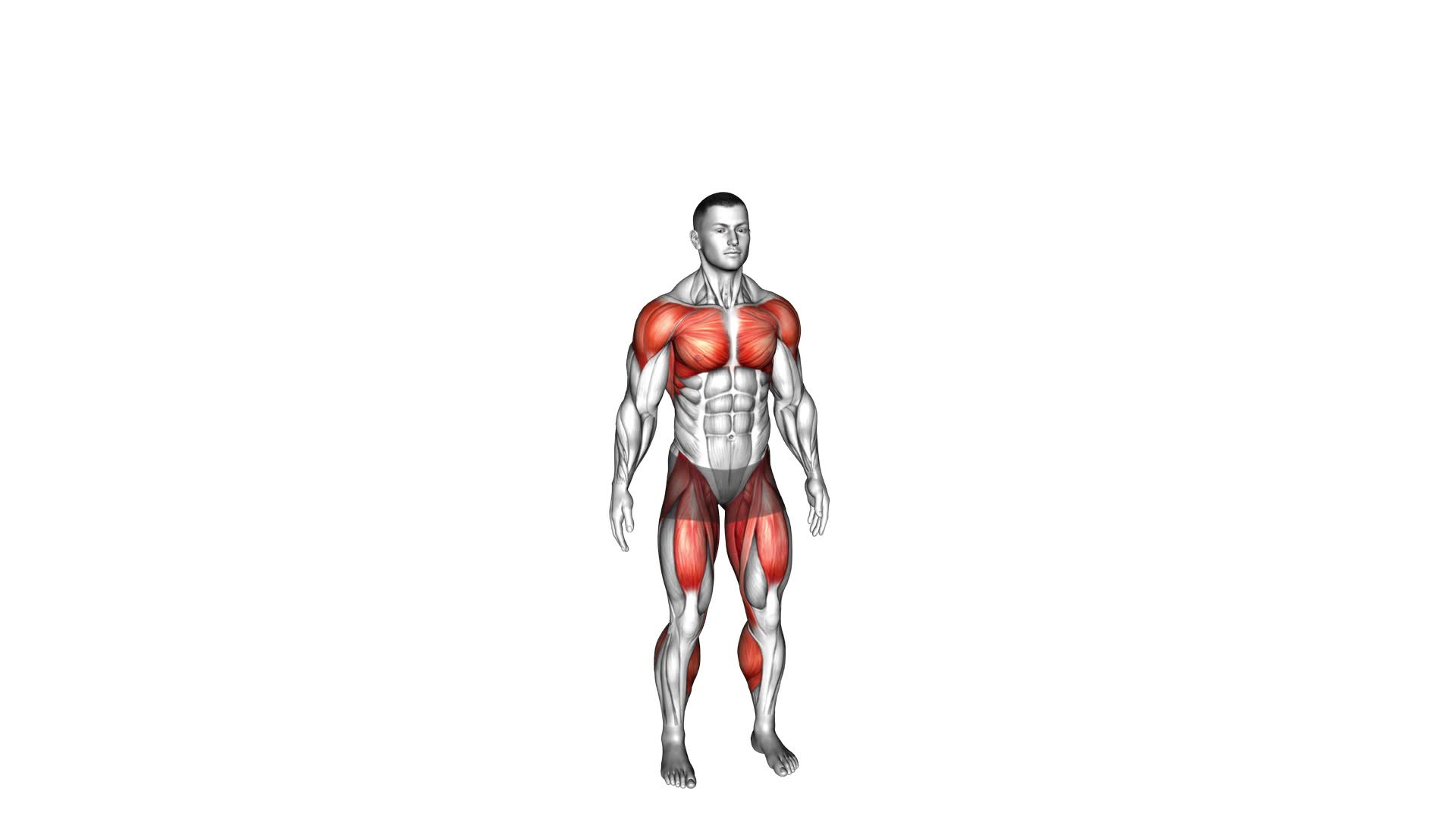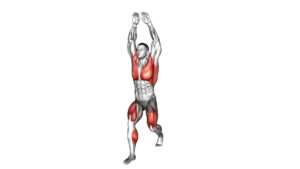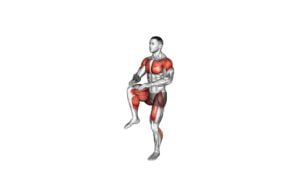Half to Full Jumping Jack (male) – Video Exercise Guide & Tips

Get ready to amp up your workout with the half to full jumping jack exercise! This dynamic move targets multiple muscle groups and boosts your cardiovascular endurance.
Watch This Exercise Video
In this video exercise guide, you'll learn the proper form and technique for executing this exercise with precision. Whether you're a beginner or an experienced fitness enthusiast, we've got modifications and progressions to suit all levels.
Say goodbye to common mistakes and hello to a more effective workout routine. Let's jump into it!
Key Takeaways
- Half to Full Jumping Jacks target multiple muscle groups, including shoulders, chest, triceps, quadriceps, hamstrings, and calves.
- These exercises boost cardiovascular endurance and engage both the upper and lower body simultaneously.
- Modifications and alternatives, such as using resistance bands or weights, stepping out to the side instead of jumping, or trying plyometric variations, can be used to challenge different fitness levels.
- Proper form and technique, including landing softly, keeping the back straight, and fully extending the arms and legs, are important to prevent injuries and maximize benefits.
Benefits of the Half to Full Jumping Jack Exercise
To maximize your workout and build strength, incorporate the half to full jumping jack exercise into your routine. This exercise is a great way to engage multiple muscle groups and increase your heart rate.
The half to full jumping jack is a variation of the traditional jumping jack, where you start with a half-jack and then progress to a full-jack motion. One of the benefits of this exercise is that it targets your upper and lower body simultaneously. As you jump and extend your arms overhead, you engage your shoulders, chest, and triceps. At the same time, your legs are working to jump and land, which strengthens your quadriceps, hamstrings, and calves.
Additionally, the half to full jumping jack is a great cardiovascular exercise. By incorporating this exercise into your routine, you can increase your heart rate and improve your cardiovascular fitness. This makes it an excellent choice for those looking to burn calories and improve their overall endurance.
If you're looking for alternatives to the traditional half to full jumping jack, there are a few variations you can try. One option is to perform the exercise with resistance bands or weights to add an extra challenge. Another alternative is to do a modified version of the exercise by stepping out to the side instead of jumping. These variations can help you switch up your routine and continue to challenge your muscles.
Proper Form and Technique for Half to Full Jumping Jacks
To perform half to full jumping jacks with proper form and technique, follow these steps.
Begin by standing with your feet together and your arms by your sides. Engage your core and jump your feet out to the sides while simultaneously raising your arms above your head. As you jump, make sure to land softly on the balls of your feet, with your knees slightly bent to absorb the impact. Keep your back straight and your shoulders relaxed throughout the movement.
To modify the exercise, you can start with half jumping jacks. Instead of jumping your feet out, step them out to the sides while raising your arms. This reduces the impact on your joints and is a great option for beginners or those with joint issues. As you build strength and confidence, gradually increase the intensity by incorporating the full jumping jack movement.
Performing half to full jumping jacks has numerous benefits. It's a dynamic exercise that engages multiple muscle groups, including your legs, core, and arms. It improves cardiovascular endurance, burns calories, and helps to tone and strengthen your muscles. Additionally, the explosive nature of the exercise activates fast-twitch muscle fibers, improving explosive power and agility.
Remember to always listen to your body and choose a modification that suits your fitness level. With practice and consistency, you'll be able to perform full jumping jacks with proper form and reap all the benefits this exercise has to offer. So, let's get moving and start jumping!
Modifications and Progressions for All Fitness Levels
Now that you've mastered the proper form and technique for half to full jumping jacks, it's time to explore modifications and progressions that suit your fitness level.
Whether you're a beginner looking for tips to make the exercise more manageable or an advanced individual seeking challenging variations, there are options for everyone.
Beginner Modifications: Tips for Beginners
For beginners, modify the Half to Full Jumping Jack exercise with these tips for all fitness levels.
If you're just starting out, it's important to make exercise modifications that suit your current fitness level. Begin by performing a modified version of the exercise. Instead of jumping both feet out and in, start by stepping one foot out at a time while raising your arms. This will help you build strength and coordination before progressing to the full movement.
Remember to listen to your body and take it at your own pace. It's also important to take safety precautions, such as warming up properly and wearing appropriate footwear.
With dedication and consistency, you'll soon be able to perform the full Half to Full Jumping Jack exercise with ease. Keep pushing yourself and don't give up!
Advanced Progressions: Challenging Variations
As you progress in your fitness journey, you can challenge yourself with advanced variations of the Half to Full Jumping Jack exercise.
These challenging variations are designed to push your limits and take your workout to the next level.
One advanced modification you can try is the Plyometric Jumping Jack. Instead of simply jumping your feet out and in, you explosively jump as high as you can, bringing your hands overhead and your feet wide apart before quickly returning to the starting position.
Another challenging variation is the Tuck Jumping Jack. In this modification, you bring your knees up towards your chest as you jump, engaging your core and adding an extra level of intensity to the exercise.
These advanced modifications won't only test your strength and endurance but also keep you motivated and excited to continue pushing your limits.
Customizing for Fitness Levels: Individualized Modifications
To cater to different fitness levels, make individualized modifications and progressions for all participants. By customizing the exercises, you can ensure that everyone is able to participate and progress at their own pace. Here are some tips for fitness level customization:
- Start with the basics: For beginners or those with lower fitness levels, it's important to start with modified versions of the exercise. This could mean performing a half jumping jack instead of a full one, or reducing the intensity by slowing down the movements.
- Increase intensity gradually: As participants become more comfortable with the exercise, you can gradually increase the intensity by adding more repetitions or performing the exercise at a faster pace.
- Provide options for modifications: Offer alternative movements or variations for individuals who may have limitations or injuries. This allows them to still participate and work within their capabilities.
- Encourage progressions: For those with higher fitness levels, challenge them with advanced variations or additional resistance to continue pushing their limits.
Common Mistakes to Avoid While Performing Half to Full Jumping Jacks
To perform half to full jumping jacks correctly, it's crucial to focus on maintaining proper form throughout the exercise. This means keeping your core engaged, chest lifted, and arms and legs fully extended.
Additionally, be mindful of avoiding any sudden or jerky movements that could lead to knee injuries. Remember to breathe deeply and exhale on the exertion to maximize the effectiveness of the exercise.
Proper Form Importance
When performing half to full jumping jacks, it's crucial to focus on maintaining proper form throughout the exercise. Proper form not only ensures maximum effectiveness but also helps prevent injuries. Here are some important points to keep in mind:
- Importance of warm up exercises: Prior to starting the half to full jumping jacks, it's essential to warm up your muscles to increase flexibility and blood flow. This will prepare your body for the exercise and reduce the risk of strains or pulls.
- Common misconceptions about proper form: One common mistake isn't fully extending your arms and legs during the jumping jack motion. Make sure to fully stretch out to engage all the targeted muscles. Another misconception is rushing through the exercise without paying attention to proper form. Take your time and focus on each movement.
- Engage your core: Throughout the exercise, engage your core muscles by pulling your belly button towards your spine. This will help stabilize your body and prevent unnecessary strain on your back.
- Land softly: As you jump and return to the starting position, make sure to land softly to minimize impact on your joints. Bend your knees slightly to absorb the shock and maintain proper form.
By following these tips, you'll be able to perform half to full jumping jacks with proper form, reducing the risk of injuries and maximizing the benefits of the exercise.
Now, let's move on to the next section and learn about avoiding knee injuries.
Avoiding Knee Injuries
To avoid knee injuries while performing half to full jumping jacks, focus on maintaining proper form and taking care of your joints. Preventing knee injuries is crucial for a safe and effective workout.
One common mistake to avoid is landing with your knees locked. This puts excessive stress on the joint and can lead to injury. Instead, aim to land softly with a slight bend in your knees.
Another mistake to watch out for is allowing your knees to collapse inward during the movement. This puts strain on the ligaments and can lead to instability.
To strengthen your knee joints, incorporate exercises like squats and lunges into your routine.
Breathing Technique Tips
To ensure proper breathing technique while performing half to full jumping jacks, it's important that you exhale during the jumping motion and inhale as you return to the starting position. Correct breathing not only enhances your performance but also provides several benefits for your body.
Here are some common breathing mistakes to avoid:
- Holding your breath: Holding your breath can lead to decreased oxygen supply to your muscles, causing fatigue and reducing your endurance.
- Shallow breathing: Breathing only into your chest limits the amount of oxygen you take in. Instead, focus on deep belly breathing to fully oxygenate your body.
- Rapid breathing: Breathing too quickly can disrupt your rhythm and decrease your energy efficiency. Take slow, controlled breaths to maintain a steady pace.
- Breathing out of sync: Make sure your exhales and inhales align with your movements. Exhale as you jump, and inhale as you return to the starting position.
Tips for Incorporating Half to Full Jumping Jacks Into Your Workout Routine
You can easily incorporate half to full jumping jacks into your workout routine for an effective cardiovascular exercise. These jumping jacks variations are a great way to add intensity and variety to your workouts.
One tip for incorporating half to full jumping jacks is to include them in your HIIT (High-Intensity Interval Training) workouts. HIIT involves short bursts of intense exercise followed by periods of rest or lower intensity activity. By adding half to full jumping jacks into your HIIT routine, you can elevate your heart rate and burn more calories in a shorter amount of time.
Another tip is to start with a few sets of half jumping jacks before progressing to full jumping jacks. This allows you to gradually build up your stamina and avoid overexertion. As you become more comfortable and confident, you can increase the number of sets and repetitions to challenge yourself even more.
To make the most out of your half to full jumping jacks, remember to engage your core, keep your chest lifted, and land softly on the balls of your feet. This will help you maintain proper form and prevent any unnecessary strain on your joints.
Now that you know some tips for incorporating half to full jumping jacks into your workout routine, let's move on to the next section where we'll provide you with a sample half to full jumping jack workout plan.
Sample Half to Full Jumping Jack Workout Plan
Get ready to incorporate a dynamic and challenging half to full jumping jack workout plan into your fitness routine. This workout plan will help you increase your workout intensity and activate multiple muscle groups.
Here's a sample workout plan to get you started:
- Warm-up: Begin with a five-minute warm-up to prepare your body for the workout. This can include light cardio exercises like jogging or jumping rope.
- Half to Full Jumping Jacks: Perform three sets of 10-12 reps of half to full jumping jacks. Start with the half jumping jack, where you only raise your arms halfway, then progress to the full jumping jack, where you raise your arms overhead and jump your legs out wide.
- Circuit Training: Combine the half to full jumping jacks with other exercises to create a circuit training routine. For example, alternate between jumping jacks and bodyweight squats or push-ups. Complete three rounds of each exercise, resting for 30 seconds between sets.
- Cool-down: Finish your workout with a five-minute cool-down to gradually lower your heart rate and stretch your muscles.
By incorporating the half to full jumping jack workout plan into your fitness routine, you'll increase the workout intensity and activate various muscle groups, leading to improved cardiovascular endurance and overall strength.
Get ready to challenge yourself and achieve your fitness goals!
Frequently Asked Questions
How Many Calories Can I Burn by Doing Half to Full Jumping Jacks?
You can burn a significant amount of calories by doing half to full jumping jacks. This exercise is a great way to boost your weight loss efforts.
By engaging multiple muscle groups and increasing your heart rate, jumping jacks can help you burn calories and shed unwanted pounds. Incorporating this exercise into your routine regularly can contribute to your overall calorie burn and support your weight loss goals.
Keep up the good work!
Can Half to Full Jumping Jacks Help Me Lose Weight?
Half to Full Jumping Jacks can definitely help you lose weight. By incorporating these variations into your workout routine, you'll engage multiple muscle groups and increase your heart rate, leading to calorie burn and weight loss.
To properly perform half to full jumping jacks, start with your feet together and arms by your sides. Jump your feet out while raising your arms overhead, then return to the starting position.
Keep up the great work and watch those pounds melt away!
Are There Any Specific Muscles Targeted During the Half to Full Jumping Jack Exercise?
During the half to full jumping jack exercise, several specific muscle groups are targeted. The main muscles engaged include the quadriceps, hamstrings, glutes, and calves.
Additionally, this exercise also works the shoulders, chest, and core muscles.
By performing variations and modifications of the jumping jack, you can further target specific muscle groups or increase the intensity of the workout.
Incorporating this exercise into your routine can be a great way to strengthen and tone multiple muscle groups while burning calories.
Can Half to Full Jumping Jacks Improve My Cardiovascular Endurance?
Half to full jumping jacks can definitely improve your cardiovascular endurance. By increasing your heart rate and breathing rate, this exercise helps to strengthen your heart and lungs. It also improves blood circulation and oxygen delivery to your muscles, allowing them to work more efficiently.
The benefits of half to full jumping jacks aren't limited to just cardiovascular health, they also help to tone and strengthen your legs, arms, and core. Plus, there are variations of jumping jacks to keep your workouts interesting and challenging.
Is It Necessary to Warm up Before Performing Half to Full Jumping Jacks?
Before performing half to full jumping jacks, it's necessary to warm up.
Warming up helps prepare your muscles and joints for the exercise, reducing the risk of injury. It also increases blood flow, which can improve your performance and range of motion.
To warm up effectively, incorporate dynamic stretches and light cardio exercises like jogging or jumping rope. Remember to start slowly and gradually increase the intensity. This will ensure you get the most out of your workout while preventing injuries.
Conclusion
Incorporating the half to full jumping jack exercise into your workout routine can bring numerous benefits. It helps improve cardiovascular fitness, strengthens muscles in the legs, arms, and core, and boosts overall body coordination.
By following proper form and technique, avoiding common mistakes, and incorporating modifications and progressions, you can maximize the effectiveness of this exercise.
So why wait? Start incorporating half to full jumping jacks into your workouts and enjoy the benefits it brings to your fitness journey. Stay motivated and keep pushing yourself to achieve your goals!

Author
Years ago, the spark of my life’s passion ignited in my mind the moment I stepped into the local gym for the first time. The inaugural bead of perspiration, the initial endeavor, the very first surge of endorphins, and a sense of pride that washed over me post-workout marked the beginning of my deep-seated interest in strength sports, fitness, and sports nutrition. This very curiosity blossomed rapidly into a profound fascination, propelling me to earn a Master’s degree in Physical Education from the Academy of Physical Education in Krakow, followed by a Sports Manager diploma from the Jagiellonian University. My journey of growth led me to gain more specialized qualifications, such as being a certified personal trainer with a focus on sports dietetics, a lifeguard, and an instructor for wellness and corrective gymnastics. Theoretical knowledge paired seamlessly with practical experience, reinforcing my belief that the transformation of individuals under my guidance was also a reflection of my personal growth. This belief holds true even today. Each day, I strive to push the boundaries and explore new realms. These realms gently elevate me to greater heights. The unique combination of passion for my field and the continuous quest for growth fuels my drive to break new ground.







